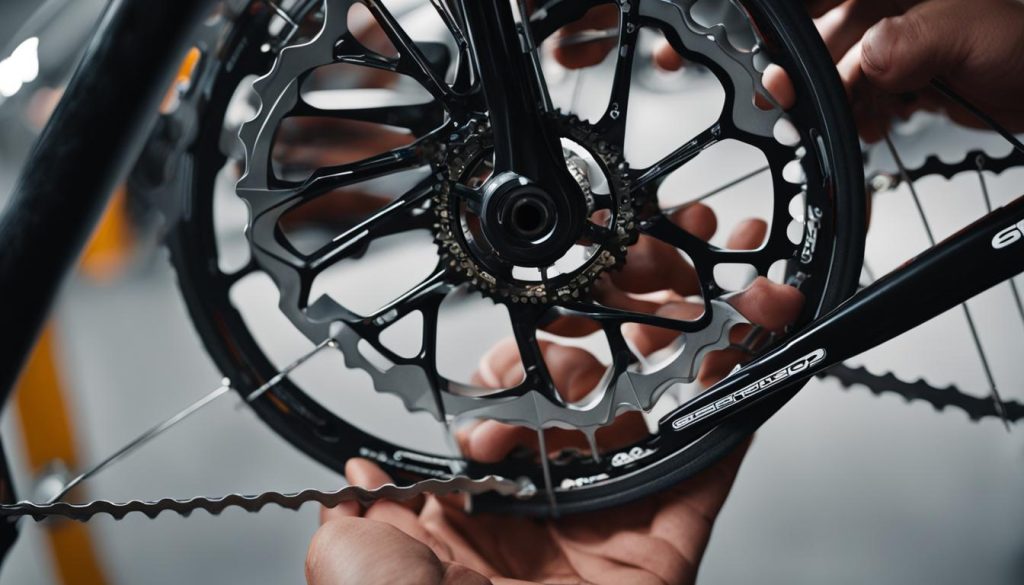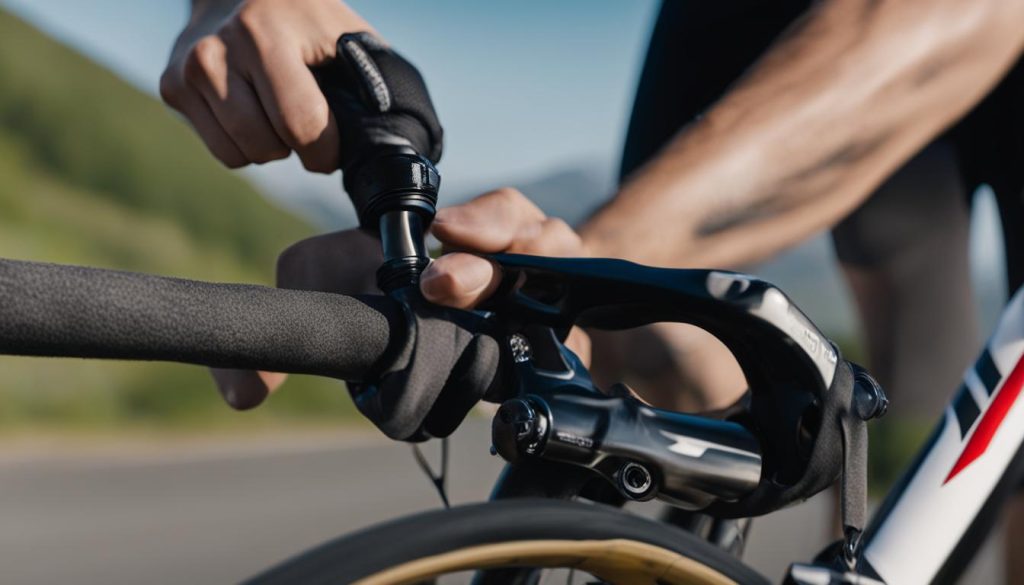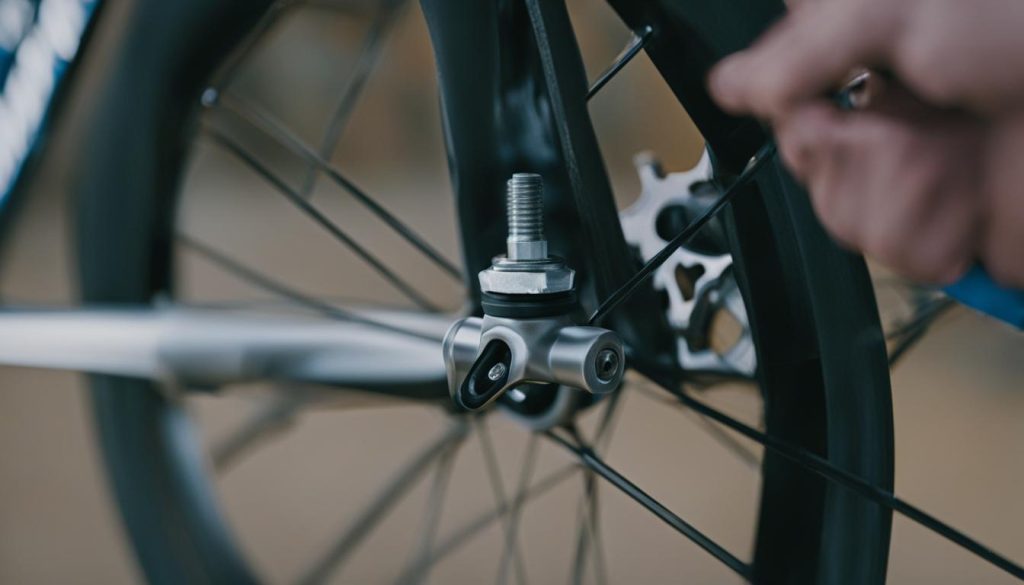Are you having trouble with your bike brakes? Don’t worry, adjusting them isn’t as difficult as it may seem. With our quick guide and tips, you’ll be able to adjust your bike brakes easily and achieve optimal performance. It’s important to keep your brakes in good working condition for your safety and the safety of those around you.
Whether you have rim brakes or disc brakes, we’ve got you covered. Our step-by-step instructions will help you fine-tune your braking system, so you can ride your bike confidently and securely.
Key Takeaways:
- Adjusting your bike brakes is essential for safety and performance.
- Regular maintenance and tuning of your brakes is necessary to keep them functioning at their best.
- Whether you have rim brakes or disc brakes, the process of adjustment is relatively simple.
- By following our quick guide and tips, you’ll be able to perform bike brake maintenance and achieve optimal stopping power.
- Always prioritize your safety and consult a professional if you encounter any major issues with your bike brakes.
Steps to Adjust Bike Brakes
Now that you know the basics of bike brake adjustment, let’s dive into the step-by-step process.(DIY bike brake adjustment, adjusting bicycle brakes) We’ll cover both rim brakes and disc brakes, providing specific instructions for each type. Remember to consult your bike’s owner’s manual for any specifics related to your particular model.
Rim Brakes
Step 1: Check brake pad alignment. Your brake pads should be positioned equidistant from the rim. If they’re not, use a 5mm Allen key to loosen the pad mounting screw. Adjust the position of the brake pad, and retighten the screw.
Step 2: Adjust cable tension. Turn the barrel adjuster on your brake lever until the brake pads are positioned 1-3mm away from the rim. Pulling the brake lever should activate the brakes immediately; adjust as necessary. (adjusting bicycle brakes)
Step 3: If you’re still experiencing issues, check the wear on your brake pads. Worn pads can reduce stopping power and may need to be replaced.
Disc Brakes
Step 1: Check brake pad alignment. Similar to rim brakes, your brake pads should be situated equidistant from the rotor. Loosen the mounting bolts, adjust as necessary, and then retighten.(adjusting bicycle brakes, steps to adjust bike brakes)
Step 2: Adjust cable tension. Most disc brake systems require minimal adjustment, but you may notice excess play in the lever. Tighten the barrel adjuster until the brake engages immediately upon being activated.
Step 3: For hydraulic disc brakes, check the brake fluid level and add more fluid as necessary. Additionally, inspect the rotor for any visible damage, and replace if needed.
Centering the Brake Caliper
If your brakes still aren’t functioning correctly, there could be an issue with the brake caliper’s centering. To fix this, loosen the mounting bolts on the caliper, and squeeze the brake lever. While holding the lever, retighten the bolts until the caliper is centered on the rotor. This may take some trial and error, but once done correctly, your brakes should be in optimal condition.(adjusting bicycle brakes, steps to adjust bike brakes)
With these detailed steps, you’ll be able to handle any bike brake adjustments on your own. However, remember to prioritize your safety and seek professional help if you encounter any major issues.
Bike Brake Maintenance and Tuning
Proper bike brake maintenance is crucial for safety and performance. Neglecting your brakes can lead to safety hazards and less confident rides.
First, perform regular cleaning and inspection of your brakes. Wipe down your rim or disc brakes with a clean cloth and check for wear and tear. Keep an eye on your brake pads and replace them if necessary. For rim brakes, ensure they are properly aligned with the rim and not rubbing or squeaking. For disc brakes, check the rotor for damage and ensure it’s not warped or bent.

Second, lubricate your brake components. Use a lubricant like Tri-Flow or WD-40 to lubricate all pivot points and moving parts. Remember not to lubricate your actual brake pads or rotors, as this can impair their effectiveness.
If you have disc brakes, adjusting them for optimal stopping power is important. Start by loosening the caliper bolts and ensuring the caliper is centered over the rotor. Then, adjust the brake pads so they are evenly spaced and not touching the rotor. Finally, adjust the barrel adjuster on the brake lever to adjust the tension of the cable.
What if you encounter some common issues with your brakes? For rim brakes, check for worn brake pads or a loose brake cable. For disc brakes, check for a warped rotor or loose bolts. Remember to always prioritize your safety and seek professional help if you are unsure.
Summary
By performing regular maintenance and adjusting your brakes properly, you can ensure they are in top condition for a smooth and safe ride. Remember to inspect, lubricate, and troubleshoot issues as needed, and always prioritize safety. With these tips, you’ll be able to confidently maintain and tune your bike brakes.
Conclusion
As we wrap up this quick guide on how to adjust bike brakes, we hope you’ve gained valuable insights and tips on maintaining your bicycle’s braking system. Remember that keeping your brakes in good condition is key to a safe and enjoyable ride.
By following the steps we’ve outlined, you’ll be able to perform DIY bike brake adjustments and fine-tune your brakes for optimal performance. However, if you encounter any major issues or are unsure about how to proceed, it’s always a good idea to consult a professional bike mechanic.
Don’t forget to practice regular bike brake maintenance, including cleaning and lubricating your brake components, to keep them functioning smoothly. If you have disc brakes, be sure to adjust them properly for maximum stopping power.
Thanks for reading, and happy cycling!
FAQ
How do I adjust bike brakes?
Adjusting bike brakes is a relatively straightforward process. For rim brakes, start by checking the brake pad alignment and adjusting the cable tension if necessary. If you have disc brakes, you’ll need to align the brake calipers and adjust the brake pads. Our detailed guides in the following sections will walk you through the specific steps for each brake type.
Can I adjust my bike brakes myself?
Yes, you can definitely adjust your bike brakes yourself. With some basic tools and our step-by-step instructions, you’ll be able to fine-tune your braking system for optimal performance. However, if you’re unsure or uncomfortable with the process, it’s always a good idea to consult a professional bike mechanic.
What tools do I need to adjust bike brakes?
The tools you’ll need to adjust bike brakes may vary slightly depending on the brake type. However, some common tools include an Allen wrench set, a cable puller or pliers, and a screwdriver. Consult our specific guides for rim brakes and disc brakes to ensure you have the necessary tools for each adjustment.
How often should I adjust my bike brakes?
The frequency of adjusting your bike brakes will depend on various factors such as your riding style, environmental conditions, and the type of brake system you have. As a general rule, it’s a good idea to regularly inspect and maintain your brakes. Pay attention to any signs of wear, unusual noises, or a decrease in braking performance. It’s better to adjust your brakes sooner rather than later to ensure safe and reliable stops.
What are some common brake issues and how do I troubleshoot them?
Some common brake issues include squealing brakes, lack of stopping power, and excessive brake pad wear. To troubleshoot these issues, start by inspecting the brake pads for alignment and wear. Check the brake cable tension and adjust if necessary. Clean and lubricate the brake components regularly to ensure smooth operation. If the problem persists, consult our detailed brake maintenance guide for further troubleshooting tips.
Should I adjust both front and rear brakes?
Absolutely. It’s important to adjust both the front and rear brakes to ensure balanced stopping power. Adjusting both brakes will help maintain stability and prevent potential accidents. Always check and adjust both brakes when performing maintenance or fine-tuning your braking system.





